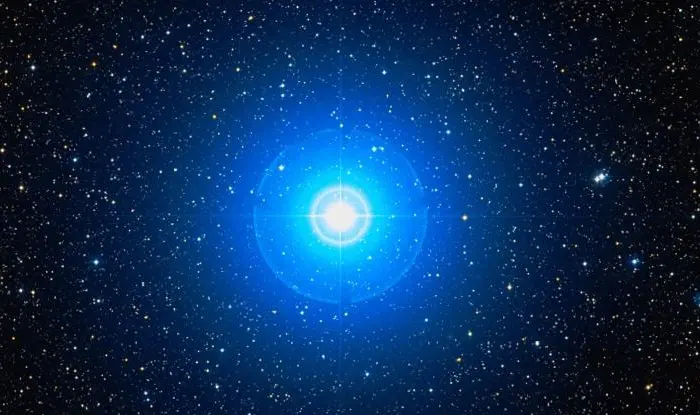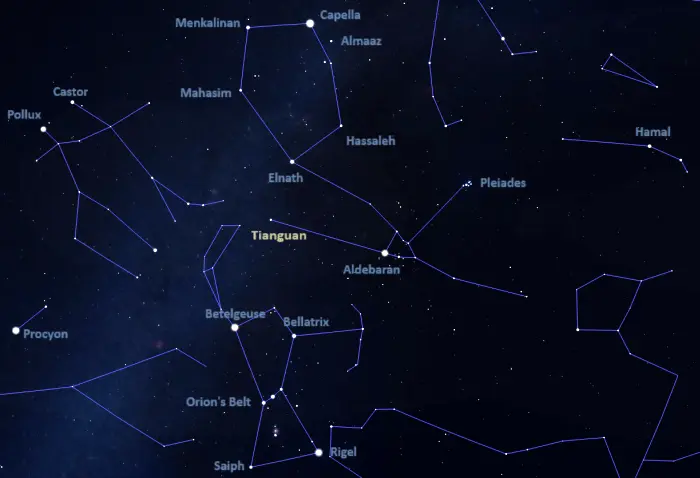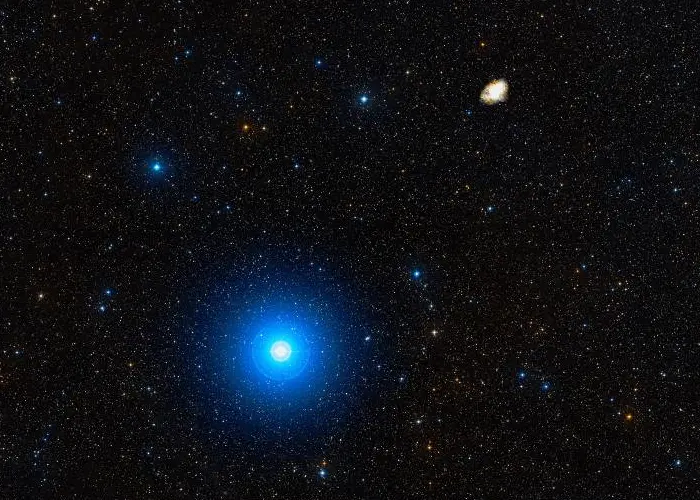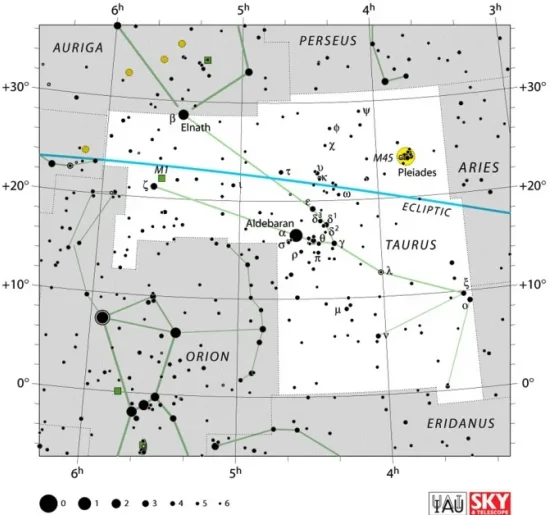Tianguan, Zeta Tauri (ζ Tau), is a hot blue giant star located approximately 440 light-years away in the zodiac constellation of Taurus. It forms a spectroscopic binary system with a smaller companion. The star has an average apparent magnitude of 3.010 and is easily visible to the unaided eye. It marks the southern horn of the celestial Bull and can be used to find the Crab Nebula (Messier 1), the best-known supernova remnant in the northern sky.
Star system
Zeta Tauri is a single-lined spectroscopic binary star system composed of a blue giant of spectral type B2 IIIpe and a smaller companion whose properties are uncertain. The two stars are locked in a close orbit and cannot be resolved even in the largest of telescopes. They are separated by only 1.17 astronomical units (AU), a little more than the distance between the Earth and the Sun. The two components complete an orbit every 133 days.
The primary component, Zeta Tauri A, is formally known as Tianguan. The giant star has a mass 11.2 times that of the Sun and a radius of 5.5 solar radii. With an effective temperature of 15,500 K, it is 4,169 times more luminous than the Sun. The star is a fast spinner, with a projected rotational velocity of 125 km/s. It has an estimated age of only 22.5 million years.

Tianguan (Zeta Tauri), image: Wikisky
The suffix “pe” in the star’s spectral class indicates chemical peculiarities in its spectrum (“p”) and the presence of emission lines (“e”).
Tianguan is classified as a Be star, a B-type star with emission lines in its spectrum. These lines are understood to come from circumstellar material expelled from the star due to its rapid rotation. Be stars have gaseous disks formed of ejected material and are often visually variable.
Tianguan has been observed to vary in brightness from magnitude 2.88 to 3.17. It is classified as a Gamma Cassiopeiae variable. Like the class prototype Gamma Cassiopeiae, these stars show irregular brightness variations on a timescale of decades. The variations are associated with transient or variable disks, which cause changes in the stellar spectra.
Other bright Gamma Cassiopeiae stars include Gomeisa in the constellation Canis Minor, Kappa Canis Majoris in Canis Major, Dschubba in Scorpius, Lambda Pavonis in Pavo, Zeta Ophiuchi in Ophiuchus, and Pleione in the Pleiades cluster (M45) in Taurus.
The rotating disk of gas around Zeta Tauri was resolved between 2007 and 2009 using the Michigan Infrared Beam Combiner (MIRC) at the CHARA array, an array of six telescopes located at the Mount Wilson Observatory in California.
Even though it is a young star, Tianguan has burned through its supply of hydrogen fuel relatively quickly due to its high mass. It is already in the final stages of its life cycle and is destined to go out as a supernova in the next few million years.
The companion, Zeta Tauri B, has a mass 94% that of the Sun. It may be a main sequence star of the spectral type G4, a neutron star or a white dwarf.
Facts
With a visual magnitude of 3.010, Zeta Tauri is on average the fourth brightest star in the constellation Taurus, after Aldebaran (Alpha Tauri), Elnath (Beta Tauri), and Alcyone (Eta Tauri). Aldebaran and Elnath are the 14th and 27th brightest stars in the sky, and Alcyone is the brightest star in the Pleaides cluster (Messier 45).
In the constellation figure of Taurus, Tianguan marks the southern horn of the Bull. The northern horn is marked by the brighter Elnath (Beta Tauri). Aldebaran (Alpha Tauri) and Ain (Epsilon Tauri) mark the Bull’s eyes and the bright Hyades stars outline its V-shaped head. The Pleiades cluster marks the Bull’s shoulder, and the fainter Lambda Tauri marks its chest.
Zeta Tauri is a member of the Taurion OB association, a stellar association discovered in 2015, that stretches over an area of about 20 by 15 degrees in the constellations Taurus and Orion. The astronomers who discovered the group proposed that the red supergiant Betelgeuse may also be a member. Other proposed members include 36 A- and B-type stars, the brightest of which are Tianguan, Tau Tauri, and Nu Orionis.
Name
The name Tianguan (pronunciation: /tiænˈɡwɑːn/) comes from the Chinese 天關 (Pinyin: Tiānguān). This was the traditional Chinese name of an asterism known as Celestial Gate (or Frontier Gate). In Chinese astronomy, the asterism was formed by Zeta Tauri with 113 Tauri, 126 Tauri, 128 Tauri, 129 Tauri, 130 Tauri, and 127 Tauri. Celestial Gate (天關) was originally a single-star asterism within the larger Net mansion, which represented the body of the White Tiger. The fainter stars were later added to it. The name Tianguan was also transliterated as Tien Kwan.
The name was approved by the International Astronomical Union’s (IAU) Working Group on Star Names (WGSN) on June 30, 2017. It formally applies only to the primary component in the Zeta Tauri system, Zeta Tauri A.
Location
Tianguan is very easy to find because it appears in a region full of bright stars and conspicuous asterisms. It is the brightest star between Betelgeuse in Orion and Elnath at the northern horn of Taurus.
Betelgeuse is part of the hourglass-shaped constellation figure of the celestial Hunter and Elnath forms Auriga’s hexagon with Capella and other bright stars in the constellation Auriga. It is the second brightest star of the hexagon, after Capella.

The location of Tianguan (Zeta Tauri), image: Stellarium
Zeta Tauri is commonly used to find the famous Crab Nebula (M1), the remnant of a historic supernova first observed in 1054. The nebula lies about a degree northwest of the star, in the direction of Elnath. It can be seen in a small telescope.

Tianguan (Zeta Tauri) and the Crab Nebula, image: Wikisky
Constellation
Tianguan is located in the constellation Taurus. Representing the celestial Bull, Taurus is one of the ancient constellations, catalogued by Claudius Ptolemy of Alexandria in the 2nd century CE. It stretches across 797 square degrees of the northern sky and is the 17th constellation in size. Taurus is easy to identify because it hosts the giant star Aldebaran, one of the brightest stars in the sky, and two of the brightest and nearest open star clusters to Earth, the Pleiades and the Hyades.
In Greek mythology, Taurus is associated with the myth of Zeus assuming the form of a white bull to abduct the princess Europa. Alternatively, the constellation is taken to represent the princess Io, whom Zeus transformed into a heifer in order to hide her from his wife Hera.

Taurus constellation map by IAU and Sky&Telescope magazine
In addition to Aldebaran and Tianguan, notable stars in Taurus include the hot blue giant Elnath (Beta Tauri), which used to belong to both Taurus and the neighbouring Auriga, the young T Tauri, a prototype for a class of variable pre-main sequence stars, the orange giant Ain (Epsilon Tauri) and the wide binary star Chamukuy (Theta Tauri) in the Hyades, and the eclipsing variable system Lambda Tauri. The brightest Pleiades stars – Alcyone (Eta Tauri), Atlas (27 Tauri), Electra (17 Tauri), and Maia (20 Tauri) – are all evolved blue giants. They are among more than a dozen stars in the cluster that are visible to the unaided eye.
The best-known deep sky objects in Taurus include the Pleiades and the Hyades, the open clusters NGC 1647, NGC 1807 and NGC 1817, the Crab Nebula (Messier 1, NGC 1952), the supernova remnant Simeis 147 (the Spaghetti Nebula), the planetary nebula NGC 1514 (the Crystal Ball Nebula), and the reflection nebulae NGC 1555 (Hind’s Variable Nebula) near the variable star T Tauri and NGC 1435 (Tempel’s Nebula) near Merope in the Pleiades. The constellation also hosts the colliding galaxies NGC 1409 and NGC 1410 and the active galaxy Markarian 1506 (3C 120).
The best time of the year to see the stars and deep sky objects in Taurus is during the month of January, when the constellation is prominent above the horizon in the evening. The entire constellation is visible from locations north of the latitude 65° S.
The 10 brightest stars in Taurus are Aldebaran (Alpha Tau, mag. 0.86), Elnath (Beta Tau, mag. 1.65), Alcyone (Eta Tau, mag. 2.87), Tianguan (Zeta Tau, mag. 2.97), Chamukuy (Theta2 Tauri, mag. 3.40), Lambda Tauri (mag. 3.47), Ain (Epsilon Tau, mag. 3.53), Omicron Tauri (mag. 3.61), Atlas (27 Tau, mag. 3.63), and Prima Hyadum (Gamma Tau, mag. 3.654).
Tianguan – Zeta Tauri
| Spectral class | B2 IIIpe |
| Variable type | Gamma Cassiopeiae |
| U-B colour index | -0.749 |
| B-V colour index | -0.264 |
| Apparent magnitude | 3.010 (2.88–3.17) |
| Absolute magnitude | -2.67 |
| Distance | 440 light-years (140 parsecs) |
| Parallax | 7.33 ± 0.82 mas |
| Radial velocity | +20 ± 2.5 km/s |
| Proper motion | RA: +1.78 ± 0.88 mas/yr |
| Dec.: -20.07 ± 0.65 mas/yr | |
| Mass | 11.2 M☉ (ζ Tauri A), 0.94 M☉ (ζ Tauri B) |
| Luminosity | 4,169 L☉ (ζ Tauri A) |
| Radius | 5.5 R☉ (ζ Tauri A) |
| Temperature | 15,500 K |
| Age | 22.5 ± 2.6 million years |
| Rotational velocity | 125 km/s |
| Constellation | Taurus |
| Right ascension | 05h 37m 38.6854231s |
| Declination | +21° 08′ 33.158804″ |
| Names and designations | Tianguan, Zeta Tauri, ζ Tau, 123 Tauri, HD 37202, HR 1910, HIP 26451, SAO 77336, FK5 211, BD+21°908, AG+21 543, GC 6985, GCRV 3468, PPM 94584, PLX 1286.00, JP11 1187, IRAS 05346+2106, 2MASS J05373868+2108331, UBV 5591, AAVSO 0531+21, TYC 1310-2697-1, Gaia DR3 3402918982515591168 |